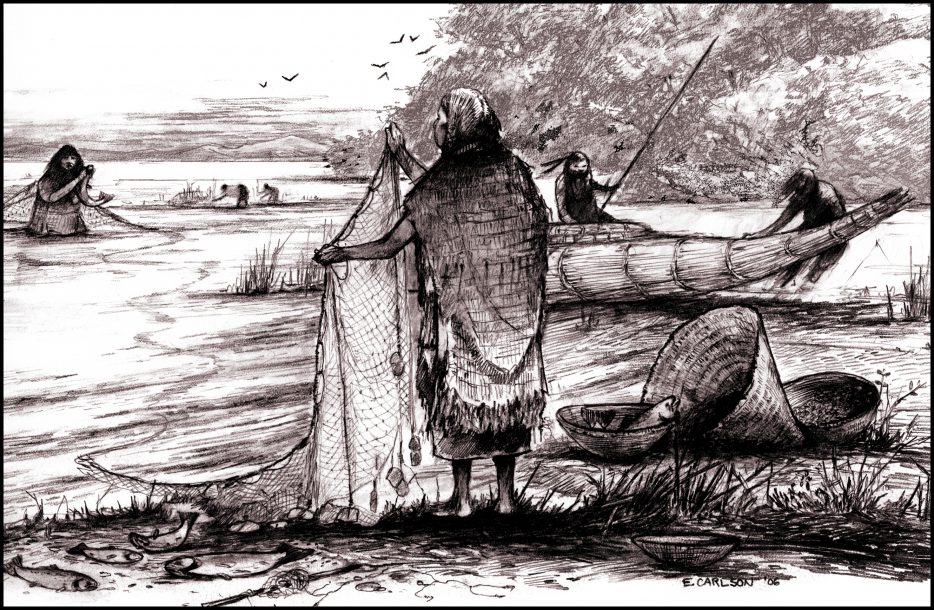Utah State University, Logan
From: Steven R. Simms, Ancient Peoples of the Great Basin and Colorado Plateau (with original artwork by Eric Carlson and Noel Carmack). New York: Routledge, 2008/2016.
The Archaic period spans over 250 human generations, over 40 times the duration of Euro-American history in Utah. In the wake of the Paleoindian explorers and colonists, Archaic “settlers” spread across the land, and over the next 8,000 years foraging societies would fully appropriate that land. Archaeologists love labels, and variously refer to this period as the Archaic, the Western Archaic, or the more colorful “Desert Culture.” There is danger in lumping such a long span of time together under a single period, let alone a single people or tribe. It would be an error to homogenize what was a wealth of cultural diversity and change simply because we labeled it as one. Nevertheless, the Archaic period stands in contrast to the Paleoindian because the time of first exploration of the continent, and the initial colonization was over. The Archaic symbolizes the settling of the land, a process that began some 10,000 – 11,000 years ago and ended with the arrival of farming less than 2,000 years ago.
Settlers of the Early Archaic (9000 – 7000 B.P.)
Climate and habitats are always “underneath” cultural change, mediating and sometimes limiting choices. Wetlands were more common in the Early Archaic than today and settlement remained tethered to the valleys because wetlands were an abundant source of foods from terrestrial and aquatic game to roots, and seeds. The uplands were not ignored, and forays were made there not only to hunt, but for collecting roots, berries, nuts, and other essential goods: medicinal plants, stone to make tools, fibers for string, nets, and baskets, minerals for paints, feathers and fur for adornment, and special woods like Mountain Mahogany and Serviceberry.
Two technologies, milling stones (the metate and mano) and coiled basketry, symbolize significant change in the Early Archaic. Milling stones were used in earlier times, as was twined basketry, but milling stones and the watertight coiled basketry became economic lynchpins. Seeds were harvested and stored during the growing season, ground into flour on the milling stone, and cooked using hot rocks to heat a porridge of seed or root flour with bits of meat and topped by fresh greens. Seeds are highly storable and sustained people during the winter.
Groups remained small, and the increased need for stored food tethered people to place. They did not fully settle, as stays were brief as people cycled among familiar valley locations. Specialized tasks required groups to split into smaller segments for weeks or even months at a time. Large amounts of briefly available food such as rabbit drives or larvae blooms (such as the brine fly larvae on Great Salt Lake) could support larger groups, renewing far-flung group connections.
There was little in the way of territoriality, but instead of concern over enemy neighbors, territoriality revolved around stored caches of food, making ownership familial and local.Trade too was mostly local, with little evidence in the Early Archaic of the movement of exotics such as Pacific shells. Early Archaic life was nevertheless full, and a smattering of jewelry such as beads and pendants remind us that people adorned themselves, signaling status, availability, and identity, and music is in evidence with the finding of bullroarers and flutes. Population sizes were low in the Early Archaic, but the social landscape was nevertheless identified, categorized, and allocated, regardless of whether it was directly inhabited at any given moment. The combination of a socially full place in a relatively empty land made for a very different social setting than what would occur later in the Archaic and thereafter.
High-Desert Foragers of the Middle Archaic (7000 – 3000 B.P.)
Times became harsh because many of the wetlands dried up, and there were two long periods in the Middle Archaic as dry as any the region has ever seen. People would never return to the footloose days of the Paleoindian colonists or even the Early Archaic settlers.
The Middle Archaic is full of irony because the footprint left across the Basin-Plateau is light once provoking archaeologists to wonder if the region was abandoned. Archaeologists no longer believe this—foragers of the world occupy less hospitable deserts than ours. People did scatter and develop an extensive sense of place. Places were specific to tasks and timing: time to collect the bitterroot or biscuitroot, and time to hunt the pronghorn in the valleys, the mule deer in the foothills, and the bighorn sheep wherever the terrain was rough. Places and times for rabbits, marmots, muskrat, squirrel, grouse, geese, and fish. A movable feast. The Middle Archaic was a time of opportunism, and a cave in Utah exemplifies this characteristic. Located on an embayment of Great Salt Lake, a spectacle of superabundance was created when winds and water were right and washed untold millions of drowned grasshoppers into ankle deep windrows up to ten miles along the beach. Naturally dried and salted, people came from many miles away when this delicacy arrived—events often decades apart. Grasshopper collection near this cave persisted over 4,000 years and shows the extensiveness of the social networks, as well as the deep knowledge of the people about their environment. The peoples of the Middle Archaic were of the same heritage as those who came before, and they are ancestors of the living tribes.
The Late Archaic and A Land Filled with Foragers (3000 B.P. – 1000 B.P.)
If the Middle Archaic is a watershed, then the Late Archaic is a culmination of the foraging way of life. Once the entire landscape became ensnared during the Middle Archaic, and every possible resource was fair game, shortfall could no longer be handled by simply adding a new resource or a new place. During the Late Archaic the wilderness came under the brunt of the foraging presence, bringing fundamental change to the way most societies in the region were organized.
Wetlands once again spread and attracted foraging peoples, but ancient life in Utah was now shaped by forces elsewhere. Maize farming had come to Arizona and New Mexico by 3000 years ago and by 2000 years ago maize crossed the Colorado River into Utah. Immigrant farmers brought new cultures, new languages, and enormous change to the indigenous Late Archaic foraging peoples. Bow and arrow technology also arrived during the Late Archaic, spreading from the northwest. Wetland settlements, along the Wasatch Front and the Sevier Valley for instance, featured villages for at least part of the year, with goods transported and stored at these central bases. Settling into villages with more substantial housing is evident in the San Rafael Swell, Moab, Torrey, and Price/Castle Valley.
The Late Archaic might be the first time we can say there were concentrations of people in lowland villages and surrounding, scattered populations of high desert foragers. The inevitable consequence of filling the land nudged societies toward territoriality, magnified notions of private property, and kinship arrangements that emphasized group boundaries more than fluidity in group membership. Like all cultural change, tension is created when some people adopt new things and others resist. Immigrating Southwestern farmers attempting to colonize Utah added population to the land and pressured the animal and plant populations upon which indigenous foragers relied. The farmers had to develop ways to live with the indigenous foragers, but the farmers had the advantage of defense, stored food, and a growing population. To the native foraging populations, the immigrant farmers were disruptive, and the appropriation of territory and resources was disastrous for some. Foraging did not disappear, and pockets of the old life existed among the farmers. The Late Archaic in some ways and places persisted until historic times.

